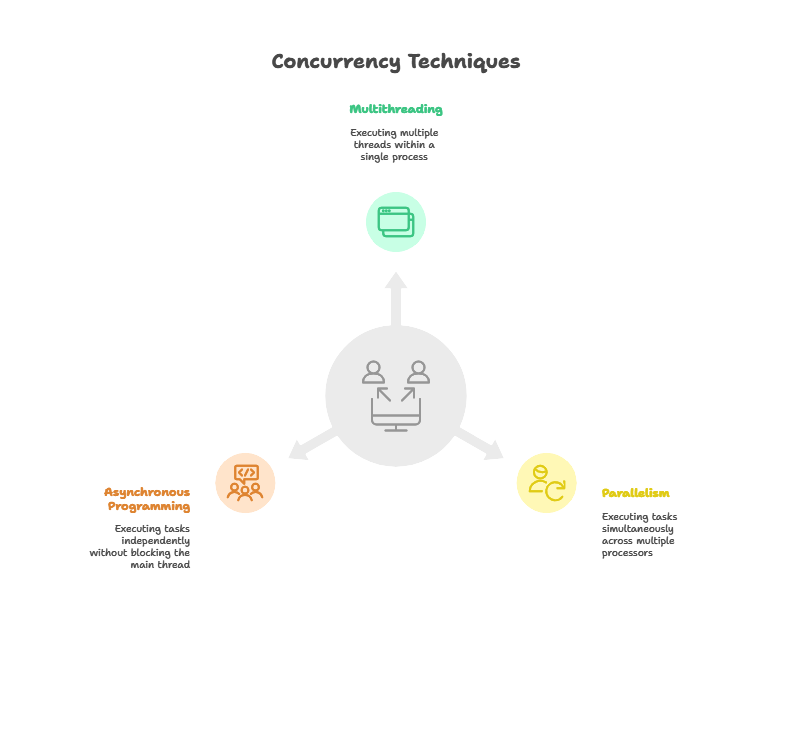Concurrency in Go
Concurrency in programming refers to the ability of a program to execute multiple tasks simultaneously. In Go, concurrency is a first-class citizen, meaning it's built into the language itself. This chapter will cover everything you need to know about concurrency in Go, from the basics to advanced techniques, with detailed explanations and examples.
Concurrency
Concurrency refers to the ability of a system to execute multiple tasks or processes simultaneously, potentially overlapping in time. In computing, concurrency enables programs to handle multiple tasks concurrently, allowing them to make efficient use of system resources such as CPU cycles, memory, and I/O devices.
Concurrency can be achieved through various mechanisms, including:
1. Multithreading: This involves executing multiple threads within a single process. Each thread represents a separate flow of execution, allowing different parts of the program to run concurrently. Multithreading is commonly used in operating systems and applications to handle tasks such as parallel processing, asynchronous I/O, and responsiveness to user input.
2. Parallelism: Parallelism involves executing multiple tasks simultaneously across multiple processors or cores. Parallelism can be achieved through techniques such as multiprocessing, where multiple processes run concurrently, or through multithreading with proper hardware support for simultaneous execution of threads.
3. Asynchronous Programming: Asynchronous programming allows tasks to execute independently without blocking the main thread of execution. It enables non-blocking I/O operations and efficient handling of tasks that may take time to complete, such as network requests or disk operations. Asynchronous programming models often use callbacks, promises, or async/await constructs to manage concurrency.
Concurrency is essential for improving the performance, responsiveness, and scalability of software systems, especially in modern, multi-core hardware environments. However, it also introduces challenges such as race conditions, deadlocks, and synchronization issues, which must be carefully managed to ensure the correctness and reliability of concurrent programs.

Understanding Goroutines
What are Goroutines?
Goroutines are lightweight threads managed by the Go runtime. They enable concurrent execution of functions without the overhead of traditional threads. Goroutines make it easy to write concurrent programs in Go.
package main
import (
"fmt"
"time"
)
func count() {
for i := 1; i <= 5; i++ {
fmt.Println(i)
time.Sleep(time.Second) // Simulate work
}
}
func main() {
go count() // Start a new goroutine
time.Sleep(time.Second * 6)
fmt.Println("Done")
}
- In this example,
count()function is executed concurrently as a goroutine using thegokeyword. - The main goroutine continues its execution without waiting for
count()to finish. time.Sleep(time.Second * 6)ensures that the main goroutine waits for 6 seconds before exiting, allowing thecount()goroutine to complete its execution.
Channels for Communication
What are Channels?
Channels are the primary means of communication and synchronization between goroutines in Go. They allow goroutines to send and receive values.
package main
import (
"fmt"
"time"
)
func sendData(ch chan string) {
ch <- "Hello" // Send data to channel
ch <- "World"
close(ch) // Close the channel
}
func main() {
ch := make(chan string)
go sendData(ch)
for msg := range ch {
fmt.Println(msg) // Receive data from channel
time.Sleep(time.Second) // Simulate work
}
}
- In this example, a channel
chof typestringis created usingmake(chan string). - The
sendDatafunction sends strings to the channelchusing the<-operator. - In
main(), we use afor rangeloop to receive values from the channel until it’s closed. - Closing the channel is essential to signal that no more values will be sent, preventing deadlock.
Select Statement for Multiplexing
The select statement in Go allows you to wait on multiple communication operations simultaneously. It’s useful for handling multiple channels efficiently.
package main
import (
"fmt"
"time"
)
func server1(ch chan string) {
time.Sleep(2 * time.Second)
ch <- "Message from server 1"
}
func server2(ch chan string) {
time.Sleep(3 * time.Second)
ch <- "Message from server 2"
}
func main() {
ch1 := make(chan string)
ch2 := make(chan string)
go server1(ch1)
go server2(ch2)
for i := 0; i < 2; i++ {
select {
case msg1 := <-ch1:
fmt.Println(msg1)
case msg2 := <-ch2:
fmt.Println(msg2)
}
}
}
- In this example,
server1andserver2functions simulate two servers sending messages with a delay. - We use the
selectstatement to receive messages from both servers concurrently. - The program prints whichever message is received first, demonstrating the non-blocking nature of
select.
Benefits of Select Statement:
- Multiplexing: Allows you to wait for multiple channels simultaneously, making it easy to handle concurrent communication.
- Non-Blocking: Select statement doesn’t block the execution if one of the channels is not ready, allowing other operations to proceed.
Concurrency in Go is a powerful feature that enables efficient utilization of resources and improves program performance. By leveraging goroutines, channels, and the select statement, developers can write highly concurrent and scalable applications. Understanding these concepts is essential for building robust concurrent programs in Go. Whether you're a beginner or an experienced developer, mastering concurrency in Go opens up new possibilities for writing efficient and responsive software. Happy coding !❤️
